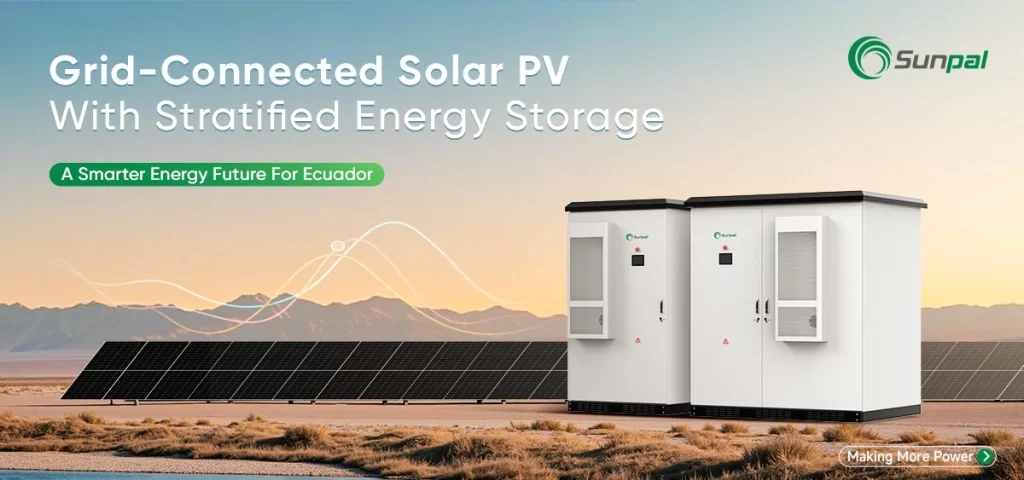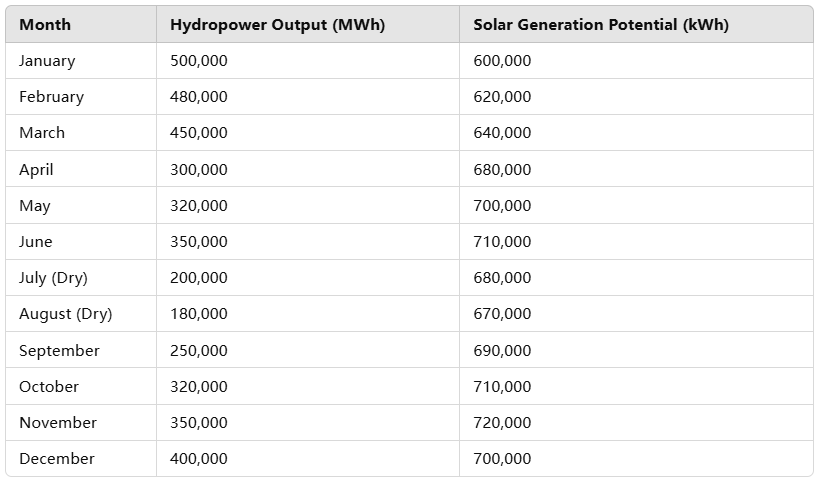
Introduction: Tackling Ecuador's Energy Challenges with Solar and Storage Solutions
Ecuador's energy grid faces significant challenges due to seasonal variations in energy supply, especially from hydropower, which is impacted during the dry season. These fluctuations often result in power shortages and price instability.
To address these challenges, Sunpal Energy is introducing a solution: grid-connected PV with stratified energy storage. This innovative technology not only maximizes solar energy use but also helps stabilize the grid by filling gaps during low solar production periods. This article explores how this approach is helping Ecuador meet its energy needs and reduce reliance on fossil fuels.
Ecuador's Energy Landscape: The Struggle with Seasonal Variability
Ecuador is heavily reliant on hydropower, which accounts for more than 50% of the country's electricity generation. However, the seasonal variation in rainfall—especially during dry periods—leads to a significant gap in energy supply. As the solar power market in Ecuador grows, there is an increasing need to leverage solar energy storage to complement solar generation.
Ecuador's energy production typically peaks in the wet season when rivers flow abundantly, yet during the dry season, hydropower production drops, leaving a gap in the energy supply. These gaps are further exacerbated by energy demand peaks, especially in urban centers and regions where industrial energy needs spike. The result is frequent energy shortages and a reliance on expensive and environmentally harmful fossil fuels.
Chart 1: Seasonal Variability of Ecuador's Hydropower Production
The chart below compares monthly hydropower production in Ecuador throughout the year, highlighting the seasonal fluctuations that cause energy shortages, particularly during the dry season.

During the dry season (July-August), hydropower output drops by nearly 40%, resulting in energy shortages, even though solar generation potential remains relatively stable.
The Promise of Grid-Connected PV Systems with Stratified Energy Storage
To mitigate the energy gaps caused by seasonal fluctuations, Sunpal Energy introduces a cutting-edge solution: stratified energy storage paired with grid-connected PV systems. Stratified energy storage utilizes multiple layers of energy storage technologies, storing excess solar energy produced during the sunniest months and releasing it during periods of low solar generation, such as the dry season.
Unlike traditional energy storage systems, stratified storage integrates multiple storage methods (like lithium-ion batteries and pumped hydro storage) to balance different types of energy needs. This solar energy storage solution is highly effective at smoothing out the daily and seasonal fluctuations in solar power production. By storing excess solar energy during peak solar months, Ecuador can mitigate the risk of power outages and provide a more stable supply of electricity to the grid.
In essence, stratified energy storage offers the flexibility to store energy during times of high generation and release it when needed most, thus helping to optimize solar energy efficiency while ensuring grid stability year-round.
Addressing Regional Specificity: Tailored Solutions for Ecuador's Energy Needs
Ecuador is unique in terms of its geography and climate. Its mountainous terrain and proximity to the equator make it ideal for solar energy generation, with high sunlight hours throughout the year. However, the variation in sunlight and hydropower production presents significant challenges that require customized solutions.
Sunpal Energy is addressing these challenges by offering solar storage solutions that are specifically designed to work within Ecuador's geographic conditions. By optimizing solar panel placement and integrating scalable energy storage solutions, Sunpal ensures that both urban and rural areas have reliable access to energy, regardless of season.
Data Analysis: Optimal Solar Panel Placement in Ecuador
A comprehensive study of solar panel efficiency based on geographical features such as altitude, latitude, and weather conditions. The analysis concludes that regions like Loja and Cuenca, with slightly higher altitudes, experience better solar irradiance throughout the year, making them ideal locations for solar farm installation.

By understanding these nuances, Sunpal Energy designs solar PV systems that are tailored to local conditions, ensuring maximum solar energy output.
Stratified Energy Storage: Solving Ecuador's Seasonal Energy Gaps
One of the most significant advantages of stratified energy storage is its ability to bridge the gaps caused by seasonal energy fluctuations. During the wet season, Ecuador enjoys a surplus of hydropower and solar energy, but the dry season leads to significant energy deficits.
With stratified energy storage, surplus solar energy can be stored in high-efficiency lithium-ion batteries or used in other storage systems during peak solar production periods. The stored energy is then made available during the dry season when solar energy production is low. This hybrid approach is a game-changer for energy storage solutions, as it provides an alternative to relying solely on traditional energy storage like pumped hydro, which has its own limitations in terms of cost and environmental impact.
Advantages for Utility-Scale Planners and Technical Specialists
For utility-scale planners, the combination of grid-connected PV with stratified energy storage represents a sustainable and cost-effective solution to meet the country's growing energy demands. By deploying scalable systems that integrate solar power generation with multi-layered storage, planners can significantly reduce reliance on fossil fuels while ensuring grid stability.
For technical specialists, the challenge lies in optimizing the storage systems for peak performance. The stratified storage solution offers several key technical benefits:
- Efficiency: The ability to capture excess solar energy and release it when needed maximizes system performance.
- Reliability: Stratified energy systems provide reliable backup power during periods of high demand.
- Flexibility: These systems can be scaled and customized based on location-specific needs, making them ideal for both urban and rural settings.
Data Analysis: Cost-Benefit Analysis of Hybrid Solar Storage Solutions
The analysis compares the costs and long-term savings of traditional fossil fuel-based energy generation versus stratified energy storage systems. Over a 20-year period, the hybrid system can save up to 40% in energy costs and significantly reduce carbon emissions, making it a smart choice for both economic and environmental reasons.

Looking Ahead: A Bright Future for Ecuador's Energy System
As Ecuador continues its transition toward cleaner, more reliable energy sources, the role of solar PV systems and energy storage solutions will only grow. The integration of stratified energy storage with grid-connected solar systems presents a viable, sustainable solution to meet the country's energy demands while addressing seasonal fluctuations.
Sunpal Energy is at the forefront of this innovation, helping to provide both urban and rural communities with reliable, affordable solar power. As Ecuador looks toward the future, this innovative approach could become a model for other countries facing similar challenges in managing seasonal energy demand.
Exploring the Potential of Stratified Energy Storage for Your Energy Needs
For utility-scale planners, energy developers, and technical specialists looking for reliable solutions to seasonal energy fluctuations, Sunpal Energy's stratified storage solutions offer the promise of a sustainable, scalable future. Contact us today to learn more about how we can help you integrate solar energy with advanced storage technologies to meet your energy needs, both now and in the future.
